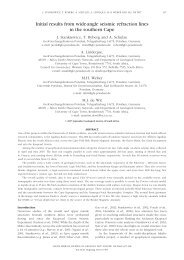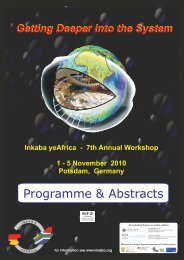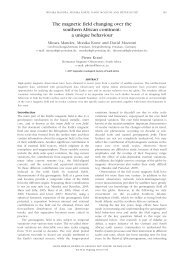South Africa - Inkaba.org
South Africa - Inkaba.org
South Africa - Inkaba.org
Create successful ePaper yourself
Turn your PDF publications into a flip-book with our unique Google optimized e-Paper software.
The design of a Stirling engine system for the Science and<br />
Technology Train<br />
T. Matsepe 1,2 , CJS Fourie 2 , L. Beneke 1<br />
1. Department of metallurgical Engineering, Faculty of Engineering at Tshwane University of<br />
Technology, <strong>South</strong> <strong>Africa</strong>, tebohomatsepe@yahoo.com, benekelw@tut.ac.za<br />
2. Department of Environmental, Water and Earth Sciences, Faculty of Science at Tshwane University<br />
of Technology, <strong>South</strong> <strong>Africa</strong>, fouriecjs@tut.ac.za<br />
ABSTRACT<br />
The Science and Technology (S&T) Train will need a constant electrical power supply. Although it is possible to<br />
use a diesel generator system to maintain a constant electricity supply, it will result in an unnecessary use of diesel<br />
and pollution. Alternative ways of electricity generation was investigated and it was decided that the best<br />
alternative solution will be a Stirling motor that uses solar energy. The diesel generator system will only be used as<br />
a backup system.<br />
A design model of an Alpha V-type Stirling Engine has to be done and built, to supply approximately an amount of<br />
100kw of electrical power, for household purposes on the Science and Technology Train. It is a double acting,<br />
twelve cylinder engine with the hot cylinders and pistons at ninety degrees out of phase with cold and hot sides (six<br />
cylinders each side). According to the Stirling thermodynamic cycle studies, an efficiency of more that 30% can be<br />
achieved (in our design 33%), therefore an amount of 300kw plus is predicted to be captured from a source of heat.<br />
The source of heat for this system is a solar parabolic dish collector, with the receiver that has been designed<br />
purposely for better capacity and large amount of heat capturing. The collector is a super corrosive resistant<br />
stainless steel tank filled with salt, with a heat exchanger and a synthetic oil fluid inside. The concentrated radiation<br />
will then be transmitted to the oil in the receiver and some be kept as a thermal energy storage, from which it can<br />
be drawn for use at night and, or cloudy days. The thermal energy storage will be achieved by pumping the heated<br />
fluid to an insulated storage tank.<br />
The receiver will be absorbing the incoming solar radiation, converting it into heat, and transferring this heat to a<br />
fluid (synthetic oil) flowing through to the reservoir and finally to the engine. Cold Water will be used to cool the<br />
cold side of the cylinders, thus absorbing some of the heat energy from the working fluid. The energy shall be<br />
disposed to heat water in the geysers, by running it through a heat exchanger.<br />
KEYWORDS: S&T Train, Stirling Engine, parabolic dish, salt heat exchanger,<br />
.<br />
.<br />
52









